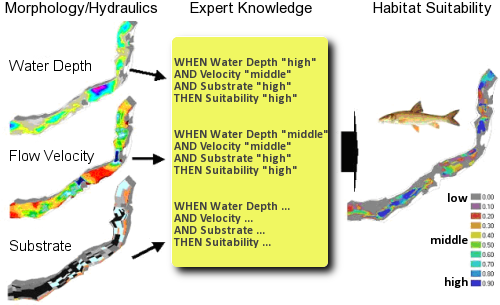Applications of the CASiMiR Model
CASiMiR Model Concept
Riverine ecosystems and their habitats are inherently complex and contain a large number of relationships between biotic and abiotic components.
Habitat models can be an appropriate instrument for studying the ecological functions of these systems. They allow for the qualitative assessment of habitat conditions for the species under consideration, most commonly for indicator species such as fish. Since the late 1990s, the Universität Stuttgart has pioneered the development of fuzzy logic based habitat simulation software, resulting in the creation of the CASiMiR software suite: Fish, Benthos, and Hydropower (JORDE 1996, SCHNEIDER et al. 2001).

CASiMiR is unique in that it makes use of physical and biological parameters through the application of expert knowledge using a fuzzy logic based rule system (JORDE et al. 2000, SCHNEIDER 2001), but can also use the standard preference function method as well. The main advantages of using habitat simulation models are that:
- The ecological condition of an aquatic ecosystem is directly coupled with the living conditions of the typical resident species.
- The use of habitat models allows for the effects of changing flow rates and structural characteristics to be account for, and to some extent, can be used to predict their impacts.
- Changes to the flow rate result primarily in impacting the water depth, flow velocity, and substrate conditions, all of which are major factors in determining the habitat suitability and can be directly evaluated with numerical models.
- Due to the direct relationship between habitat conditions and flow rate, a quantitative basis can be established whereby an overall ecological assessment of the habitat requirements can be performed.


